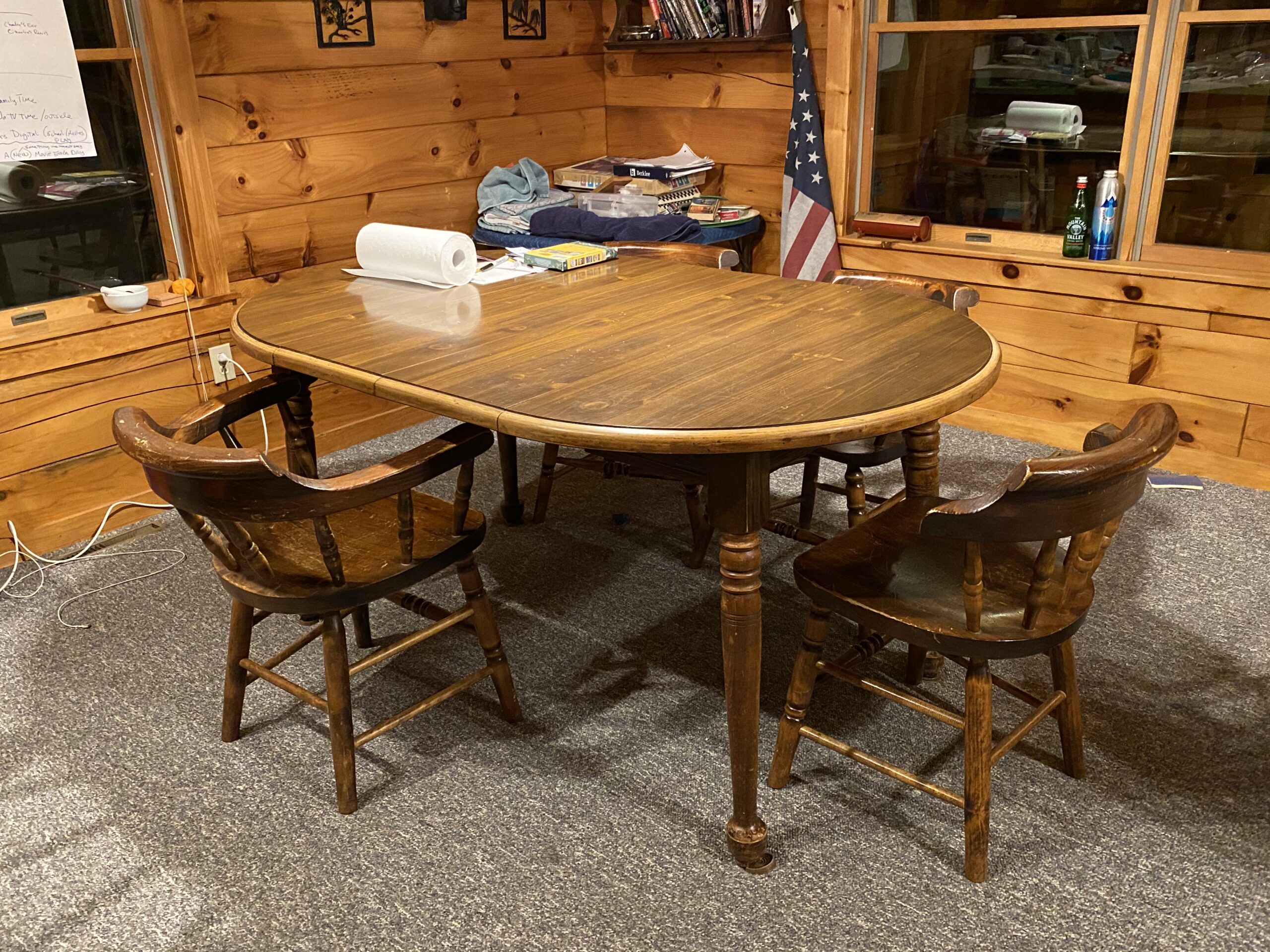Vintage dining table w/ faux-wood surface: tested positive for Lead, Cadmium, Mercury & Antimony! Do you have a table like this?
Introduction (for those new to this website):
Tamara Rubin is an independent advocate for consumer goods safety. She is also a mother of Lead-poisoned children. She began testing consumer goods for toxicants in 2009 and was the parent-advocate responsible for finding Lead in the popular fidget spinner toys in 2017. Tamara uses XRF testing (a scientific method used by the U.S. Consumer Product Safety Commission) to test consumer goods for the presence of toxicants (toxic heavy metals), including Lead, Cadmium, Mercury, Antimony and Arsenic.
XRF reading for plastic (faux-wood) surface veneer of what is otherwise a solid wood vintage table:
60-second test
- Lead (Pb): 1,253 +/- 40 ppm
- Cadmium (Cd): 284 +/- 10 pp
- Mercury (Hg): 190 +/- 22 ppm
- Chromium (Cr): 918 +/- 185 ppm
- Antimony (Sb): 24 +/- 10 ppm
- Silver (Ag): 20 +/- 3 ppm
- Palladium (Pd): 20 +/- 3 ppm
- Platinum (Pt): 62 +/- 30 ppm
- Zinc (Zn): 185 +/- 21 ppm
- Iron (Fe): 8,481 +/- 310 ppm
- Indium (In): 44 +/- 6 ppm
- Vanadium (V): 676 +/- 185 ppm
- Titanium (Ti): 5,467 +/- 478 ppm
What’s the concern here?
With a table like this, I highly recommend using a table cloth, placemats and dishes when eating meals (as one might normally use!) My primary concern would be if a young child were using this table for meals and if they had a habit of eating directly off of the table’s surface (as young children often tend to do — this is especially likely with the new/modern high chairs that clip on to the edge of the table, using the table surface instead of a separate tray!)
What should I do if I have a table like this?
If you do have young children and own a vintage table like this one, I encourage you to find a modern alternative. Ikea has plain (unfinished) solid wood tables available in the $200-$300 range. I would consider safely disposing of a table like this one (as opposed to donating the table or gifting it to someone). I am truly concerned about the mercury levels in the surface coating (in addition to the Lead readings), and I don’t fully know the implications of this finding – but I expect it’s not a good thing (and is potentially immediately harmful to the user.) I think, as an advocate (when funds permit), I would love to send a piece of the plastic surface veneer of a table like this to a lab for further testing — to see if they also find similar levels of Mercury, Cadmium, Antimony and Lead with digestive testing in a laboratory setting. (Here’s a post I wrote about disposal of Leaded items.)
What else can I do?
(To help make sure families are not potentially impacted in the future.)
Additionally I would use a permanent marker (like a wide flat-tip black sharpie) and write in BIG BOLD LETTERS on the underside of the table that it is toxic and has these dangerous heavy metals in the food surface… that way if it does somehow wind up getting passed down to another family, they at least will have some knowledge of the concern.
As always, please let me know if you have any questions; I will do my best to answer them personally as soon as I have a moment.Thank you for reading and for sharing my posts.
Tamara Rubin
#LeadSafeMama


Never Miss an Important Article Again!
Join our Email List





Hello,
Would this only be in vintage tables? I have a table purchased in 2005 like this. Is 2005 considered vintage? I honestly didn’t know it had a faux wood surface until the baby corner guards pulled off the faux wood.
I do have an older Ethan Allen table that looks the same! I was told it has a “formica” top, so I googled formica and it is simply plastic bonded to particle board. I didn’t know this! We are planning to move and were debating about whether to take the set with us or not. We will dispose of it as we will be living next door to our five grandchildren, all under seven years old. No way do I want it around them. Thank you so much!
I’m interested in knowing what levels of Cadmium (Cd), Mercury (Hg), Chromium (Cr),
and Antimony (Sb) are considered to be safe.
There’re are no regulatory limits for Antimony in most consumer goods (just for crib mattresses sold in California.) Chromium is found in many things (stainless steel, tanned leather) and I do not believe it has a safety limit (although it may for certain applications) – it is not considered to be a metal of concern. Cadmium is unsafe for kids at levels of 40 ppm and up. I believe there is a “no safe limit” standard for Mercury in some applications – and ppb or ppt limits in things like shellfish. I don’t believe a safety limit has been set for consumer goods (at least I have not come across it in my research.) Said another way – all Mercury is bad.
What kind of toxins would be added if you wrote with a big fat sharpie?
I need a new dining table for my family. It seems everything is stained, lacquered, and/or sealed. Do you have concerns or recommendations for new solid wood tables?
Thank you!
Sharyn